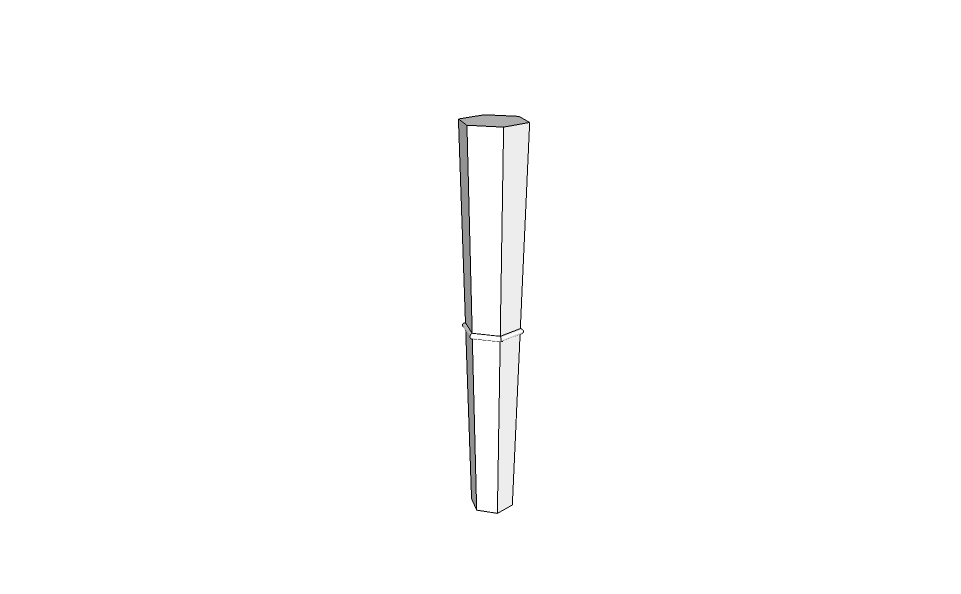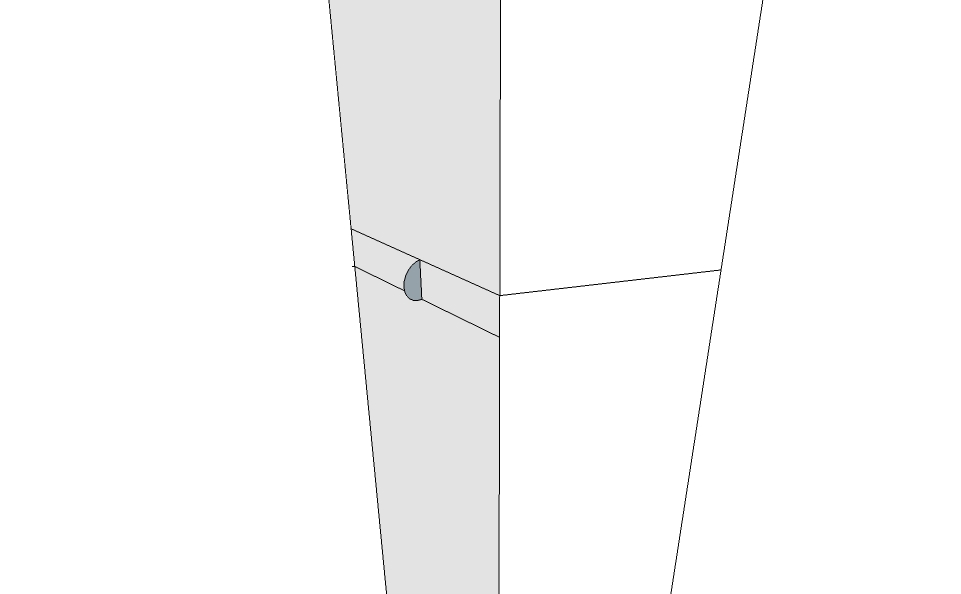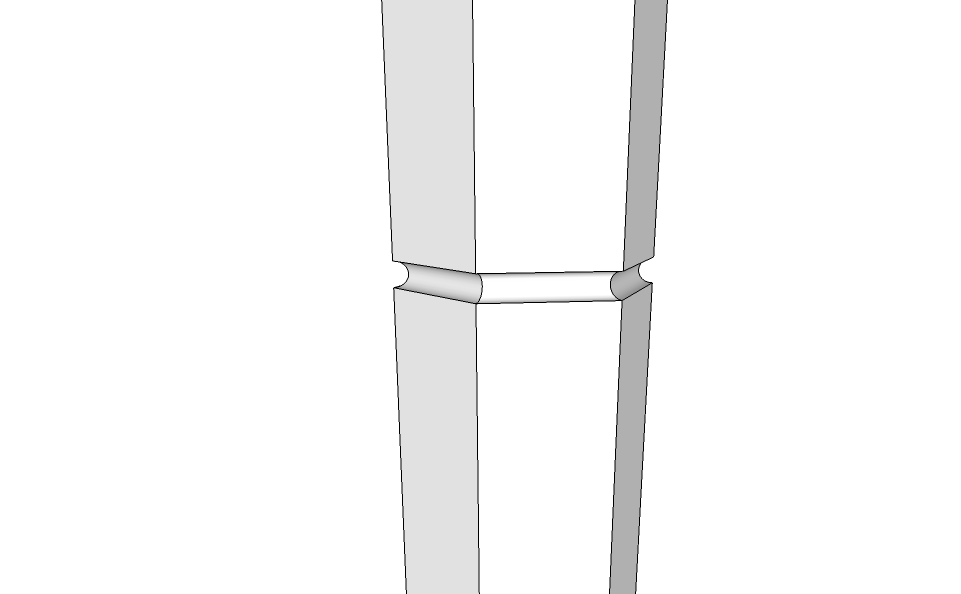Extruding on a tapered polygon.
-
I am trying to draw a polygon (36 inches tall, 6 sided) which I want to have tapered (6 inches at top, 4 inches at bottom), with a 1/2 inch half circle extrusion in the middle of each side, all the way around. First, I did the taper without any problem. But, I am having trouble to make the end of the extrusion "close" itself at the end of the polygon - it goes around all 6 sides fine, and 5 of the "corners" are fine, but the last "corner" doesn't close all the way. Is there some way to do this? I am sure there must be, but I can't figure it out. Any advice?? Thanks. And, BTW, Happy New Year to everyone.

-
Hi Mel,
Happy New Year to you as well.
Do you have any pictures that kind of show what you are trying to do? Are you trying to run a bead around the tapered column? If so, draw the profile along the midline of a side rather than at the corner. Run Follow Me on that.
I've added an example. Hopefully that illustrates what you want to do.
-
@dave r said:
Hi Mel,
Happy New Year to you as well.
Do you have any pictures that kind of show what you are trying to do? Are you trying to run a bead around the tapered column? If so, draw the profile along the midline of a side rather than at the corner. Run Follow Me on that.
I've added an example. Hopefully that illustrates what you want to do.
Thanks, but I want to do an inset extrusion (round dado) all the way around the leg. But, your suggestion is close.
-
Oh, alright. I see. Give me a minute or two and I'll make you an example.
-
Something like this?

I can think of several ways to do it but this one is fast and easy. From the origin in the SKP model:
- Use a guideline or two to assist in locating the groove. Delete on face of the column. Draw the profile of the groove along the guideline.
- Run Follow Me on the profile. I prefer to preselect the path before getting the tool and then, after getting the Follow Me tool, clicking on the profile.
- Delete the unwanted edges at the corners. this will also get rid of the face over the groove.
- Use the Line tool to trace edges to heal the missing faces.
cove on tapered column.skp
You could also delete the top or bottom face and work on the inside of the column or do several other things.
-
This is what I get, doing it my way. I will try your way. Thanks.
BTW - I don't know whether my attachment will go with this message - how do you attach models to these posts?
Meltapered leg 2.skp -
I was thinking more like this. Starting with a 4 inch polygon...moving to 36" blue...resize to 6"...create one surface parallel to an axis...locate the 1/2" bead location...draw 1/2" bead in the center of the surface...create the other surfaces...draw one edge of the bead on the other surfaces...follow me. follow me?

-
SU likes profiles started and ended on perpendicular surfaces. Try it starting your follow me in the center of a surface.

-
Mel, your model uploaded fine and it shows exactly what I would expect of Follow Me when run as you did.
The way I illustrated works perfectly however.
Good work mics_54 but he wants a cove not a bead.

-
-
Or a reverse bead.

-
Oh a cove. OK I'll butt out..too many cooks etc. etc.

-
@dedmin said:
Great help...thanks. Let ME try that now! I think it will take me more than 50 seconds.
-
SUCCESS...look Mom, I did it!! Thanks for everyone's help.
Now, I have another question (this one should be simple, but I can't find an understandable answer in any of the tutorials or manuals...how do I draw a finite guide line on the face of a surface (like on all the faces of the tapered leg WE just made)? All I seem to get is guidelines that run from left to right into infinity.
Thanks again...I am slowly getting the hang of this.
Mel
-
Good work.
You can draw a finite guideline by dragging from a point. The guideline will end in a guidepoint. Is there a reason you need a finite guideline?
FWIW, dedmin's method works but isn't strictly accurate. The profile isn't drawn perpendicular to the first leg of the Follow Me path so it results in a cove that is not cylindrical. In this application that isn't likely to be a problem nor will it be noticeable. If this was something for which you were going to end up creating a template to trace or something along those lines, starting the with the profile not perpendicular could be problematic.
-
@dave r said:
Good work.
You can draw a finite guideline by dragging from a point. The guideline will end in a guidepoint. Is there a reason you need a finite guideline?
It doesn't seem to work for me...The line always goes perpendicular to where I want it to be. I have tried toggling the CTRL key, but that doesn't help. I have tried holding down the left button on the mouse, and that doesn't help either.
The reason I would like to learn this is for positioning "things" on the face of a tapered surface, etc. Maybe it's not important, but now I am annoyed I can't do it! It worked ONCE for me, but I can't seem to figure out why.
Thanks. If not, I can probably live without it. -
Watch for a PM in a moment.
-
-
Very good Jean.
Sometimes it would make sense to go back and start drawing the whole thing over rather than trying to modify what you've already drawn. Follow Me on the whole profile would be quick and easy. As with dedmin's method of adding in the profile at the corner, the result of starting the profile at a corner will result in the groove's shape being modified from the semi-circular profile to an elliptical shape. No one would be able to tell that by looking at the model so it would be of little consequence but there may be times when that would be important to remember.
-
Hi Dave, hi folks.
You are rigth. The "Follow me" Tool first operation is to rotate any profile that is not perpendicular to the start of the path in such a way that it becomes perpendicular. the only problem is that it is not really a rotation but a projection. In this case of a circular groove, it will, indeed, becomes elliptical.
In my example, I just drew a circle centered on the midpoint of the slanted side and then I erased the unwanted part to get a circular grove. A more refined method would be to carefully position this "cutting" circle to mimick, as well as possible, the positioning of a real life router bit.
Another possibility would be to carefully position a cylinder on one side of the leg, then do an intersection and finally delete unwanted geometry. After that, a circular array can be made with the grooved face to obtain 5 more. This would work but is a lot of work.
Just ideas.
Advertisement







